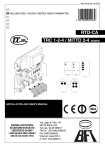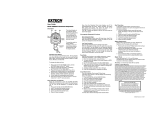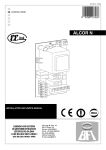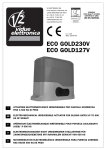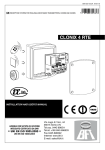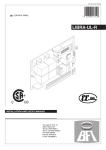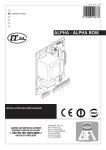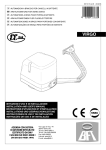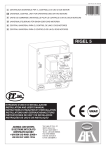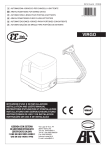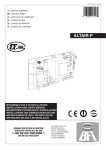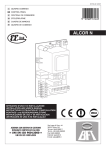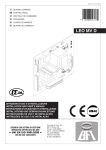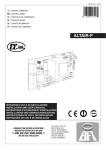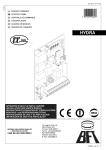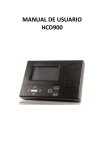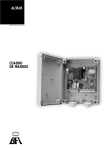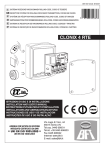Download RTD TRC 1-2-4 / MITTO 2
Transcript
D811347 ver.03 17-07-03 I RADIOCOMANDO ROLLING-CODE PROGRAMMABILE PROGRAMMABLE ROLLING-CODE RADIO TRANSMITTER RADIO COMMANDE ROLLING-CODE PROGRAMMABLE PROGRAMMIERBARE FERNSTEUERUNG MIT ROLLCODE 8 027908 196811 RADIOMANDO ROLLING-CODE PROGRAMABLE RADIOCOMANDO ROLLING-CODE PROGRAMÁVEL RTD TRC 1-2-4 / MITTO 2-4 433MHz 88 88 ISTRUZIONI D'USO E DI INSTALLAZIONE INSTALLATION AND USER'S MANUAL INSTRUCTIONS D'UTILISATION ET D'INSTALLATION INSTALLATIONS-UND GEBRAUCHSANLEITUNG INSTRUCCIONES DE USO Y DE INSTALACION INSTRUÇÕES DE USO E DE INSTALAÇÃO Via Lago di Vico, 44 36015 Schio (VI) Tel.naz. 0445 696511 Tel.int. +39 0445 696533 Fax 0445 696522 Internet: www.bft.it E-mail: [email protected] INSTALLATION MANUAL Thank you for buying this product, our company is sure that you will be more than satisfied with the product’s performance. The product is supplied with a “Warnings” leaflet and an “Instruction booklet”. These should both be read carefully as they provide important information about safety, installation, operation and maintenance. This product complies with the recognised technical standards and safety regulations. We declare that this product is in conformity with the following European Directives: 89/336/EEC and 73/23/EEC (and subsequent amendments). GENERAL SAFETY WARNING! An incorrect installation or improper use of the product can cause damage to persons, animals or things. • The “Warnings” leaflet and “Instruction booklet” supplied with this product should be read carefully as they provide important information about safety, installation, use and maintenance. • Scrap packing materials (plastic, cardboard, polystyrene etc) according to the provisions set out by current standards. Keep nylon or polystyrene bags out of children’s reach. • Keep the instructions together with the technical brochure for future reference. • This product was exclusively designed and manufactured for the use specified in the present documentation. Any other use not specified in this documentation could damage the product and be dangerous. • The Company declines all responsibility for any consequences resulting from improper use of the product, or use which is different from that expected and specified in the present documentation. • Do not install the product in explosive atmosphere. • The construction components of this product must comply with the following European Directives:It complies with the 89/336/EEC, 1999/5/CEE, European Directive and subsequent amendments. As for all non-EEC countries, the above-mentioned standards as well as the current national standards should be respected in order to achieve a good safety level. • The Company declines all responsibility for any consequences resulting from failure to observe Good Technical Practice when constructing closing structures (door, gates etc.), as well as from any deformation which might occur during use. • The installation must comply with the provisions set out by the following European Directives:It complies with the 89/336/EEC, 1999/5/CEE, European Directive and subsequent amendments. • Disconnect the electrical power supply before carrying out any work on the installation. Also disconnect any buffer batteries, if fitted. • Fit an omnipolar or magnetothermal switch on the mains power supply, having a contact opening distance equal to or greater than 3mm. • Check that a differential switch with a 0.03A threshold is fitted just before the power supply mains. • Check that earthing is carried out correctly: connect all metal parts for closure (doors, gates etc.) and all system components provided with an earth terminal. • Fit all the safety devices (photocells, electric edges etc.) which are needed to protect the area from any danger caused by squashing, conveying and shearing. • Position at least one luminous signal indication device (blinker) where it can be easily seen, and fix a Warning sign to the structure. • The Company declines all responsibility with respect to the automation safety and correct operation when other manufacturers’ components are used. • Only use original parts for any maintenance or repair operation. • Do not modify the automation components, unless explicitly authorised by the company. • Instruct the product user about the control systems provided and the manual opening operation in case of emergency. • Do not allow persons or children to remain in the automation operation area. • Keep radio control or other control devices out of children’s reach, in order to avoid unintentional automation activation. • The user must avoid any attempt to carry out work or repair on the automation system, and always request the assistance of qualified 12 - RTD- Ver. 03 • personnel. Anything which is not expressly provided for in the present instructions, is not allowed. 1) GENERAL OUTLINE Programmable self-learning radio receiver system, having the following main features: • Receiver which can be cloned with 512 or 2048 codes • Up to 4 outputs (1 standard + 3 modular) with automatic recognition of the modules entered • Outputs which can be configured as monostable, bistable, timed, anti-aggression • Programming by means of incorporated display • Operation with fixed and variable codes • Compatible with EElink protocol for fast installation and maintenance • Group function for automatic entry of groups of transmitters • Protection of receiver by means of password. The RTD receiver combines the characteristics of utmost safety in copying variable code (rolling code) coding with the convenience of carrying out transmitter “cloning” operations thanks to an exclusive system. Cloning a transmitter means creating a transmitter which can be included automatically within the list of the transmitters memorised in the receiver, either as an addition or as a replacement of a particular transmitter. Therefore it will be possible to remotely program a large number of additional transmitters, or for example, replacement transmitters for those which have been lost, without making changes directly to the receiver. Replacement cloning is used to create a new transmitter which takes the place of the one previously memorised in the receiver; in this way the lost transmitter can be removed from the memory and no longer be usable. When coding safety is not a decisive factor, the RTD receiver allows you to carry out fixed code additional cloning, which although abandoning the variable code, provides a high number of coding combinations, while maintaining the option of “copying” any receiver already programmed. Using clones when there is more than one receiver (as in the case of communal buildings), and especially when a distinction is to be made between clones to be added to or replaced in individual or collective receivers, could turn out to be rather difficult. The RTD receiver cloning system for communal buildings makes it particularly easy to solve the problem of clone storage for up to 250 individual receivers. Passageway control is managed by an output with a N.O. contact; when needed, the number of outputs can be increased by means of appropriate MOP optional modules to obtain a maximum of 4 output channels, which can be configured independently. 2) TECHNICAL SPECIFICATIONS 2.1) Receiver Power supply: .................................................. 230V ±10%50Hz (*) Frequency: ....................................................................... 433.92MHz Working temperature: .................................................... -20 to +55°C Coded by means of: ....................................... Rolling-code algorithm No. combinations: ................................................................ 4 milliard Antenna impedance: ................................................. 50 Ohm (RG58) Dimensions: .......................................................................... see fig. 1 Relay contact: ................................................................... 0,5A, 12V= Degree of protection: ................................................................ IP 20* Max no. radio transmitters to be memorised: Receiver version No. radio transmitters RTD 512 512 RTD 2048 2048 (*) The degree of protection of the container becomes IP55 with the use of an accessory supplied on request. Only use fittings suitable for the container dimensions and cable diameter. D811347_03 ENGLISH D811347_03 INSTALLATION MANUAL 2.2) MITTO Transmitter Keys: .......................................................................................... yellow Power supply: ......................... 2 3V lithium batteries (CR2016 type) Range: ......................................................................... 50–100 metres Transmitter versions: MITTO2 – double-channel, MITTO4 – four-channel 2.3) TRC Transmitter Keys: ............................................................................................... red Power supply: ...................................................... 12V alkaline battery Range: ......................................................................... 50–100 metres Transmitter versions: TRC1 – single-channel, TRC2 – double-channel, TRC4 – four-channel Accessories (optional): RTD-RS Additional board for controlling the RTD receiver via modem MOP (Fig. 2) Plug-in module provided with an additional output with N.O. contact. 3) INSTALLATION Having laid out the connection cable route, proceed to fixing the support (fig. 1) after marking the two holes through the slots available as templates on the container. Based on the material the support is made of, directly use the screws supplied or drill the holes using a 4mm-diameter bit to insert the plugs supplied. Fully tighten the screws, and compensate any centring errors using the slots on the container. 4) CONNECTION DIAGRAM (Fig. 3) Various types of installation are possible depending on the number of outputs available. Fig. 4 illustrates an example of an installation for an RTD receiver provided with 4 outputs. NOTE: For this type of installation, it is indispensable to choose the place for the antenna with great care. RTD JP4 1-2 JP3 3 4 Power supply input 230 V ±10% 50/60Hz(1L-2N) Output for COM common contact Output for NO normally open contact. Contact for door opening control JP2 5-6 Input for antenna (5 signal – 6 braid) JP7-JP8-JP9 Plug-in inputs for MOP optional modules MOP (optional) JP1 1-2 Output for NO normally open contact. Contact for door opening control. ANTENNA INSTALLATION Use an antenna tuned to 433MHz. For antenna to receiver connection, use RG8 coaxial cable. The presence of metallic masses next to the antenna can interfere with radio reception. In the case of insufficient transmitter range, move the antenna to a more suitable position. 5) PROGRAMMING Transmitters can be memorised by means of the incorporated display programmer or the UNIRADIO programmer, which makes it possible to create installations in the “collective receivers” mode, as well as manage the complete installation database through the EEdbase software. In the case of standard installations where no advanced functions are required, it is possible to proceed to manual transmitter storage, making reference to programming tables A and B. ENGLISH Programming menu description Add: Allows you to add a transmitter to a receiver memory. Three modes can be used: Auto: the transmitter is entered in the first memory location available. Manual: the number of the memory location where to enter the transmitter is requested. This mode turns out to be useful in the case where you wish to assign progressive numbers to the various transmitters, in order to simplify any subsequent elimination from the receiver memory. Group: menu for automatic entry of groups of transmitters. See paragraph 5.1 “Transmitter groups”. After selecting the automatic mode, proceed as follows: 1) Use the + and – buttons to select the output you wish to activate. If the “all outputs” option is selected, each transmitter key is automatically associated with its corresponding output (T1– Output 1, T2 – Output 2 etc.). 2) Press hidden key P1 on the transmitter. 3) Press the required transmitter key (T1, T2, T3 or T4) you wish to associate with the previously selected output. Note: Hidden key P1 has a different function depending on the transmitter model. For TRC 1-2 / MITTO 2-4, press hidden key P1 (fig. B1A). For TRC 4, the key P1 function corresponds to simultaneously pressing the 4 transmitter keys or, after opening the battery compartment, bridging the two P1 points by means of a screwdriver (fig. B1A). The cloned transmitters are automatically entered in the first memory location available. IMPORTANT NOTE: STICK THE KEY LABEL (MASTER) ON THE FIRST MEMORISED TRANSMITTER. In the case of manual programming, the first transmitter assigns the key code to the receiver; this code is necessary in order to carry out subsequent cloning of the radio transmitters. Delete: Allows you to delete one or all the entered transmitters from the receiver memory. Code: allows you to eliminate a transmitter from the receiver memory by entering the memory position number (see Addmanual menu). List: allows you to eliminate ALL the transmitters from the receiver memory. You will be requested to confirm this operation in order to avoid unwanted deletions. Verify: Allows you to check the presence of a transmitter in the memory, or to display the list of all the transmitters entered. Read code: requires you to press a key on the transmitter and, if memorised, it displays the memory location number and the key number. Scroll list: press the + and - buttons to scroll the list of all the radio transmitters memorised; keep the button pressed to speed up list scrolling. Output: Allows you to configure the functions of the outputs available in the receiver. Configure outputs 1, 2, 3 and 4: select the output you wish to configure using the + and – buttons. Each output can be configured according to the following modes: 1) impulse (monostable). The relay of the associated output remains picked up as long as the respective transmitter key remains pressed. 2) step by step (bistable). The relay of the associated output changes status each time the transmitter key is pressed. 3) timed. Each time the transmitter key is pressed, the output relay stays picked up for 90 seconds. If the key is pressed during the count cycle, the count is reset). RTD- Ver. 03 - 13 INSTALLATION MANUAL 4) anti-panic. The relay of the associated output changes status if the key is kept pressed for more than 5 seconds. All the keys of all the transmitters entered in the receiver are automatically provided with the anti-aggression function, regardless of their configuration, therefore no key (T1, T2, T3 or T4) needs to be assigned to the output. Relay commutation lasts 10 sec. Notes: The default outputs are configured as monostable. Only one output can be configured with anti-aggression mode. In the case where it is necessary to check the mode of an output configuration, select the output and press the OK key. The receiver displays the previously set function mode as the first option. If you try to configure an output which is not provided with a MOP option module, the “module not present” error message will be displayed. Configure RTD: Allows you to set the general system functions. Language: select one of the languages available (Italian, French, German, English, Spanish). Password: use the + and - buttons to enter a password consisting of 4 digits (from 0 to 9). If a value other than the default value (0000) is entered, the access password will be requested for the subsequent configuration attempt. If you do not wish to protect receiver programming by means of a password, re-enter default value 0000. Type of receiver: select the receiver function mode between fixed code and variable code (rolling-code); the receiver default configuration is set to rolling-code mode. 5.1) Transmitter groups Use menu Add --> Group to enter a large number of transmitters automatically (the maximum limit being the receiver memory capacity). The company markets packs containing 100 transmitters, appropriately programmed and numbered from 01 to 100 (transmitter 100 is identified by figure 00), which can be entered as groups. Entering a group simply requires the storage of the first and last transmitters, all the group transmitters included between these will automatically be stored in the memory. RTD receiver memory locations In order to maintain some kind of uniformity with the transmitter numbering, the receiver memory locations are assigned as follows: 1) If the memory is empty, the first transmitter (ex. 01) is entered in location 01 and the others follow, as indicated: RTD 01 02 03 04 05 06 -- -- -- -- -- -- 100 01 02 03 04 05 06 -- -- -- -- -- -- 00 2) If some of the locations are taken up by other transmitters, the first transmitter (ex. 01) is entered in the first “N01” (101-201-301, etc.) location available, which is followed by a sufficient number of free entry locations: RTD 01 02 03 04 05 -- -- 101 102 103 -- 01 02 03 -- -- 200 -- 00 3) If the receiver is empty and the first transmitter has a number other than 01 (ex. 35), the first transmitter is entered in location 35, and the others follow: RTD Standard transmitters cannot be entered in the group menu. To enter transmitter groups, proceed as follows: 1) Move to menu Add --> Group and select the output to be activated. Select option “all outputs” to have each transmitter key automatically associated with the corresponding output (T1- Output1, T2 Output2 etc.). 2) The display shows the message “First transmitter” and then “hidden key”, press the hidden key (P1 - Fig.5) of the first transmitter (lowest number) you wish to enter. 3) The display shows the message “key required”: press the Tx key you wish to associate with the output selected previously. 4) The display shows the message “Last transmitter” and then “hidden key”, press the hidden key (P1) of the last transmitter (highest number) you wish to enter. 5) The display shows the message “key required”, press the Tx key of the last transmitter. Note: the Tx key selected during this phase must be the same as that selected in point 3. 6) The display shows the first memory location taken up, confirm by pressing the “OK” key and the display will show the last memory location taken up, then press the “OK” key again. In the case where you wish to cancel a group entered, press the + and – keys at the same time. 14 - RTD- Ver. 03 01 02 03 -- -- -- 35 36 37 38 -- -- 100 35 36 37 38 -- -- 00 4) If some of the locations are taken up and the first transmitter has a number other than 01 (ex. 35), it is entered in the first “N35” (135235-335 etc.) location available, which is followed by a sufficient number of free entry locations: RTD -- 35 36 37 38 39 -- 135 136 137 -- -- 200 35 36 37 -- 00 -- D811347_03 ENGLISH D811347_03 INSTALLATION MANUAL 5) In the case where more than 100 transmitters need to be stored in the memory, each individual sales pack has to be entered by means of the group menu. Each pack is identified by a specific serial number (S/N): RTD 01 -- 01 -- -- 100 101 -- -- S/N 123.4 00 01 -- -- 200 201 -- -- S/N 123.4 00 01 -- -- 300 -- -- 00 -- ENGLISH 9) DISPOSAL ATTENTION: disposal should only be carried out by qualified personnel. Materials must be disposed of in conformity with the current regulations. In case of disposal, the system components do not entail any particular risks or danger. In case of recovered materials, these should be sorted out by type (electrical components, copper, aluminium, plastic etc.). For battery disposal, refer to the current regulations. The descriptions and illustrations contained in the present manual are not binding. The Company reserves the right to make any alterations deemed appropriate for the technical, manufacturing and commercial improvement of the product, while leaving its essential features unchanged, at any time and without undertaking to update the present publication. S/N 123.4 IMPORTANT NOTES: • The sales pack can be divided into several groups (for ex. transmitters from 01 to 50 in one system, from 51 to 65 in another, etc.) In any case, any of the remaining transmitters can be used: - on the same RTD receiver at a later time, in other groups or with manual/automatic mode, - in other RTD systems, other groups or with manual/automatic mode, - in other transmitters with standard mode. • Each transmitter contained in the pack is individually labelled according to the following sequence: 123.4.01. The first four figures (123.4) identify the pack serial number which is identical for all the transmitters belonging to the same pack. The last two figures (01 - 02 --> 00) are used to number the transmitters in the pack in progressive order. Each pack includes a printed form where to record the destination of each transmitter, you are recommended to fill it in to facilitate future maintenance, updating, replacement etc. • In the case where no transmitters have been previously entered in the RTD receiver, the first transmitter in the first group stored takes on the master transmitter function. Mark it with the appropriate adhesive “key” label. Error messages If any errors occur when entering groups, check that: the transmitters belong to one group pack (ERR1); the entry order is not reversed, the first transmitter must have an identification number lower than that of the last one. Also check that the first and last transmitters belong to the same group (ERR2); the receiver has a sufficient number of consecutive free locations for entering the transmitter group (ERR3); the key assigned to the channel (T1, T2, T3 or T4) is the same for the first and the last transmitter entered. 6) RADIO-TRANSMITTER CLONING Rolling-code cloning / Fixed-code cloning Make reference to the UNIRADIO Instructions and the CLONIX Programming Guide. 7) ADVANCED PROGRAMMING: COLLECTIVE RECEIVERS Make reference to the UNIRADIO Instructions and the CLONIX Programming Guide. 8) MAINTENANCE The maintenance of the system should only be carried out by qualified personnel regularly. The MITTO transmitters are supplied by two 3V lithium battiers (type CR2016).The TRC transmitters are powered by a 12V alkaline battery.When replacing the batteries type CR2016 do not touch the poles with thehands. Any reduction in the transmitter capacity may be due to the batteries getting flat. When the led of the transmitter flashes, it means that the batteries are flat and must be replaced. RTD- Ver. 03 - 15 LEGENDA ACCESS TO MENUS +/- 8888 Press the OK key OK + OK BFT RTD1.0 00 [ 00 ] Software version - + PRG Preset value Message: Programming in progress Parameter increment/reduction or ON/OFF commutation Message: KO! (value or function error) Menu scrolling (+ = preceding - = following) Message: “Wait” (enter value or function) /ON /OFF No. radio control devices memorised OK Simultaneously press the + and - keys. Simultaneous pressure of the + and – keys allows you to exit the active menu and return to the preceding menu; if this takes place at the main menu level, programming is exited and the display switched off. The modifications made are only confirmed if the OK key is subsequently pressed. +/ADD OK aut. out1 . .4 - + +/- - + man. END ALL out1 . .4 pos. OK hidden button P1 desired button Tx desired button Tx - + ALL Group out1 . .4 OK First tras. hidden button P1 - + - + ALL 0100 OK OK 0001 Tx desired button +/delete OK code +/- database End pos. t0001 . . . - + confirm OK - + +/verify OK read code 01 t1 . . . 2048 t4 - + +/- scroll archive End - + FOLLOWING MENUS FIG. B 16 - RTD- Ver. 03 01 t1 . . . 2048 t4 OK P1 hidden button Last tras. D811347_03 Fig. A D811347_03 Fig. B FIG. B2A FIG. B1A P1 PRECEDING MENUS FIG. A T1 T2 T1 T2 P1 T1 TRC 1-2 T3 T4 MITTO 2-4 TRC 4 T1 T2 T3 T4 T2 TRC 1-2 TRC 4 +/output OK +/END - + out1 monos OK - + - + out 2 bist - + - + out 3 timed - + - + out 4 OK antipanic +/configure RTD language ita OK - + +/- fra - + END deu - + - + ENG - + ESP password 0--- -0-- --0- ---0 OK - + rec. type codice fisso OK - + rolling code RTD- Ver. 03 - 17 44 35 T2 T1 75 75 T1 12.5 T1 T2 T1 T4 T2 T2 82 65 T3 T3 16 16 T4 45 16 45 MITTO 2 TRC 1-2 MITTO 4 34 0 11 7 14 42 - RTD- Ver. 03 TRC4 18.5 D811347_03 Fig. 1 D811347_03 Fig. 2 8 88 8 RTD- Ver. 03 - 43 D811347_03 Fig. 3 100 mA T 1 2 JP5 RTD + OK 5 6 3 4 RTD 44 - RTD- Ver. 03 4 DOOR JP2 5 6 ANT. JP1 MOP 1 2 NO N 3 SHIELD L JP3 ANT 2 NO 1 COM JP4 NO COM NO DOOR D811347_03 Fig. 4 m 2x1,5m RG58 T1- OUT1 2x1mm 2 RTD 2x1m m2 T3 A 2 OU OU T1 T2- OUT2 2x 1m m2 2x 1m m2 T3- OUT3 T4 OUT2 OU T4- OUT4 RTD- Ver. 03 - 45 D811347_03 Fig. 5 C4 TR P1 T1 T1 2 T 3 T 4 T TRC 1-2 T2 Led MITTO 2-4 P1 P1 P1 Fig. 6 RTD UNIRADIO UNIFLAT 88 88 Contatti Contacts Contacts Kontakte Contactos Contatos UNIFLAT UNIFLAT Contatti Contacts Contacts Kontakte Contactos Contatos UNITRC UNIFLAT TRC4 UNITRC UNIMITTO TRC1-2 Contatti Contacts Contacts Kontakte Contactos Contatos UNITRC MITTO 2-4 TRC1-2 TRC4 2 UNIMITTO 1 3 46 - RTD- Ver. 03 1 4 2 3 4












